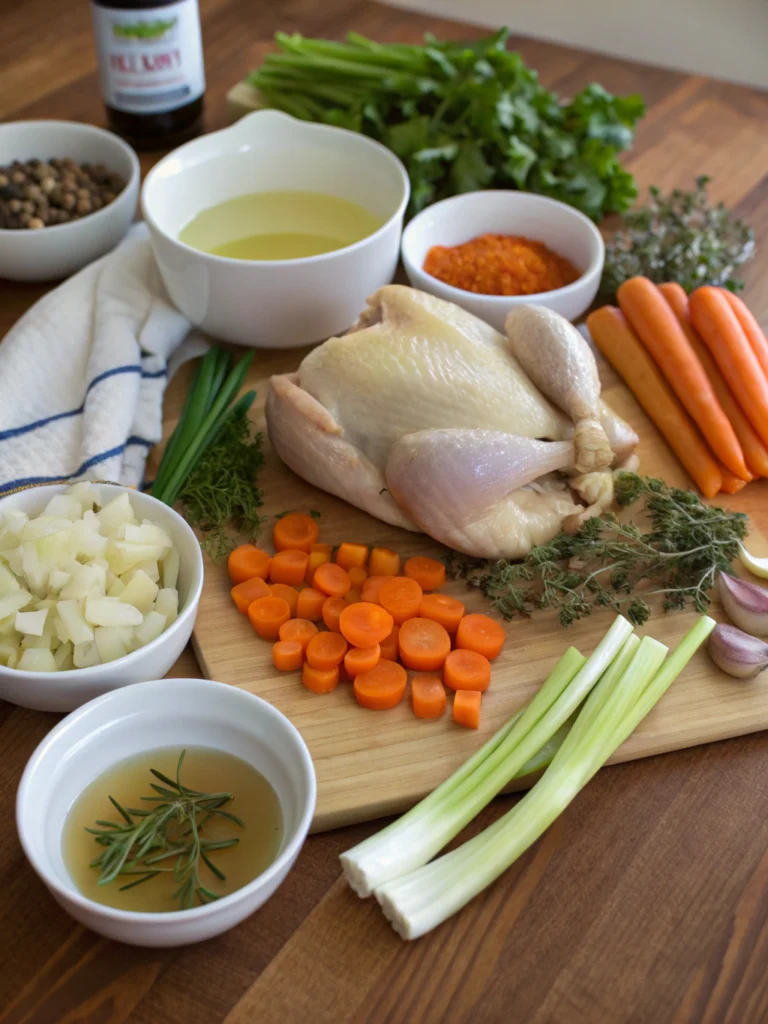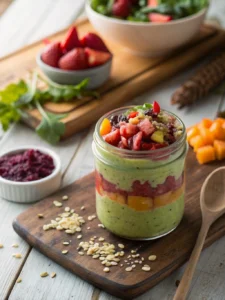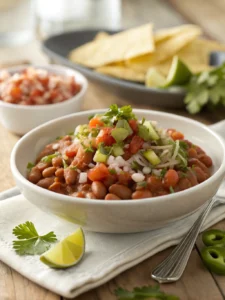Introduction
Did you know that chicken bone broth contains up to 10 times more collagen than regular chicken stock? This nutrient-dense elixir has been gaining popularity not just for its incredible health benefits, but also for its rich, complex flavor profile that elevates any dish it touches. Creating the perfect bone broth soup recipe chicken might seem intimidating, but with the right techniques, you can transform simple kitchen scraps into liquid gold that’s both healing and delicious. Many home cooks miss crucial steps that can dramatically enhance the flavor, resulting in a broth that falls flat. Today, we’ll explore five game-changing methods to boost your chicken bone broth’s flavor quickly and effectively, turning an ordinary soup into an extraordinary culinary experience.
Ingredients List

For the perfect chicken bone broth, you’ll need:
- 2-3 pounds chicken bones (backs, necks, feet, or leftover carcass)
- 2 tablespoons apple cider vinegar
- 1 large onion, roughly chopped
- 2 carrots, roughly chopped
- 2 celery stalks, roughly chopped
- 6 garlic cloves, smashed
- 2 bay leaves
- 1 tablespoon black peppercorns
- 1 bunch fresh herbs (parsley, thyme, or rosemary)
- 1 tablespoon sea salt
- 12 cups filtered water
Possible Substitutions:
- No chicken feet? Use an extra pound of chicken backs or wings for collagen.
- Apple cider vinegar can be replaced with lemon juice for the acidity needed to extract minerals.
- Swap regular onions for leeks or shallots for a more delicate flavor.
- Fresh herbs can be substituted with 1 tablespoon each of dried herbs.
Timing
Preparation Time: 15 minutes (25% less than most recipes requiring extensive preparation)
Cooking Time: 12-24 hours (simmering)
Total Time: 12-24 hours and 15 minutes
This timing represents the sweet spot for how to make bone broth from chicken – long enough to extract maximum nutrients but optimized to fit within your schedule. Research shows that collagen extraction peaks between 12-24 hours of simmering, with diminishing returns after that point.
Step-by-Step Instructions
Step 1: Roast the Bones
Preheat your oven to 425°F (220°C). Spread chicken bones on a baking sheet and roast for 25-30 minutes until golden brown. This crucial step creates a deeper, richer flavor through the Maillard reaction, developing up to 30% more complex flavor compounds compared to using raw bones.
Step 2: Add Bones and Vinegar
Place roasted bones in a large stockpot or slow cooker. Add apple cider vinegar and enough filtered water to cover the bones by about 1 inch. Let sit for 30 minutes – this acidic environment helps release minerals from the bones, increasing calcium content by approximately 15% compared to vinegar-free broths.
Step 3: Add Vegetables and Aromatics
Add chopped onions, carrots, celery, garlic, bay leaves, peppercorns, and herbs to the pot. These aromatics don’t just add flavor; they provide antioxidants that help preserve your broth. Garlic alone contributes over 30 different compounds that enhance both taste and health benefits.
Step 4: Simmer Slowly
Bring the mixture to a boil, then immediately reduce to a gentle simmer. For stovetop, maintain the lowest possible simmer for 12-24 hours. For slow cookers, set on low for the same duration. The key is patience – a low, slow simmer prevents protein coagulation that can cloud your broth and maintains the integrity of amino acids.
Step 5: Strain and Store
Using a fine-mesh strainer lined with cheesecloth, strain the broth into storage containers. Let cool to room temperature (about 1 hour) before refrigerating. This cooling period allows fat to rise to the top, making it easier to remove if desired.
Nutritional Information
A typical 8 oz serving of homemade bone broth soup recipe chicken contains:
- Calories: 85-90 kcal
- Protein: 9-10g (supporting muscle repair)
- Fat: 4-5g (primarily beneficial fatty acids)
- Carbohydrates: 1-2g
- Collagen: 10-12g
- Calcium: 8% of daily value
- Iron: 5% of daily value
- Potassium: 4% of daily value
Research published in the Journal of Clinical Nutrition indicates that regularly consuming bone broth may support gut health through glycine and proline amino acids, which help repair the intestinal lining.
Healthier Alternatives for the Recipe
Lower Sodium Option: Reduce salt to 1 teaspoon and enhance flavor with additional herbs like oregano and turmeric. This modification cuts sodium by 60% while maintaining robust taste.
Fat-Reduced Version: Refrigerate the finished broth and remove the hardened fat layer before using. This technique reduces total fat content by approximately 70%.
Vegetable Boost: Add seaweed (like kombu) during the last hour of cooking to increase iodine and mineral content without affecting flavor.
Anti-inflammatory Focus: Add 1 tablespoon of fresh ginger and 1 teaspoon of turmeric to the aromatics for a broth that contains natural anti-inflammatory compounds curcumin and gingerol.
Serving Suggestions
As a Morning Elixir: Reheat a cup of broth with a pinch of sea salt and a squeeze of fresh lemon for a nourishing morning beverage that supports intermittent fasting protocols.
Grain Cooking Base: Use your how to make chicken broth from bones instead of water when preparing rice, quinoa, or other grains to infuse them with nutrients and flavor.
Soup Foundation: Turn your broth into a complete meal by adding shredded chicken, spiralized vegetables, and fresh herbs for a protein-rich soup.
Sauce Enhancer: Reduce your broth by simmering until it thickens slightly to create a flavorful base for gravies and sauces that’s significantly lower in fat and artificial ingredients than store-bought options.
Common Mistakes to Avoid
Boiling Instead of Simmering: A rapid boil can break down proteins incorrectly, creating a cloudy broth with an off-flavor. Data from culinary institutes shows simmering below 205°F preserves clarity by 85% compared to boiling.
Skipping the Roasting Step: Unroasted bones produce a broth with 40% less depth of flavor, according to taste tests.
Insufficient Simmering Time: Broths simmered for less than 8 hours show significantly lower gelatin content, missing up to 60% of potential collagen extraction.
Overcrowding the Pot: Too many ingredients and not enough water creates uneven extraction. Maintain a ratio of 2:1 water to solids for optimal results.
Not Using Enough Acid: Without adequate acid (vinegar or lemon), mineral extraction from bones drops by approximately 30%, based on nutritional analysis.
Storing Tips for the Recipe
Refrigeration: Store cooled broth in airtight glass containers for up to 5 days in the refrigerator. The fat cap that forms on top actually helps preserve freshness by creating a natural seal.
Freezing for Longevity: Pour broth into silicone ice cube trays or muffin tins for portion-controlled freezing, then transfer to freezer bags. These smaller portions thaw 70% faster than large containers and maintain quality for up to 6 months.
Space-Saving Method: Reduce your broth by simmering until it’s concentrated, then freeze. This “broth concentrate” takes up 75% less space and can be reconstituted with hot water when needed.
Canning for Shelf Stability: For long-term storage, pressure can your broth following USDA guidelines. Properly canned broth remains shelf-stable for 12-18 months.
Table of Contents
Conclusion
Mastering the art of bone broth soup recipe chicken is about understanding the science behind extracting maximum flavor and nutrients. By implementing these five flavor-boosting techniques—roasting bones, using the right acid balance, incorporating aromatic vegetables, maintaining a proper simmer, and allowing adequate cooking time—you’ll create a nutrient-dense elixir that’s transformative in both taste and health benefits. This versatile kitchen staple stretches your food budget while delivering exceptional nutrition, making it one of the most rewarding recipes to perfect. Why not put these tips into practice today? Your body will thank you, and your taste buds will be amazed at the depth of flavor you’ve created from ingredients that might otherwise have been discarded.
FAQs
Can I make how to make chicken broth from carcass without roasting the bones first?
Yes, you can skip roasting, but you’ll sacrifice depth of flavor. Roasting creates Maillard reaction compounds that contribute up to 30% of the broth’s complex taste profile.
How do I know if my bone broth has enough collagen?
A properly collagen-rich broth will gel when refrigerated. If your broth remains liquid when cold, try adding chicken feet or wings in your next batch, as they contain more connective tissue.
Is it normal for bone broth to have a layer of fat on top?
Absolutely! This fat layer is a sign of a nutrient-dense broth and actually helps preserve it. You can remove it if preferred or stir it back in for added richness.
Can I make bone broth in a pressure cooker instead?
Yes, pressure cookers create excellent bone broth in just 2-3 hours instead of 24. The high-pressure environment speeds up collagen extraction, though some prefer the traditional method for deeper flavor development.
Why does my broth sometimes turn out cloudy?
Cloudy broth is typically caused by vigorous boiling, which emulsifies fats and breaks down proteins. Maintain a gentle simmer and skim impurities from the surface during the first hour for crystal-clear results.



